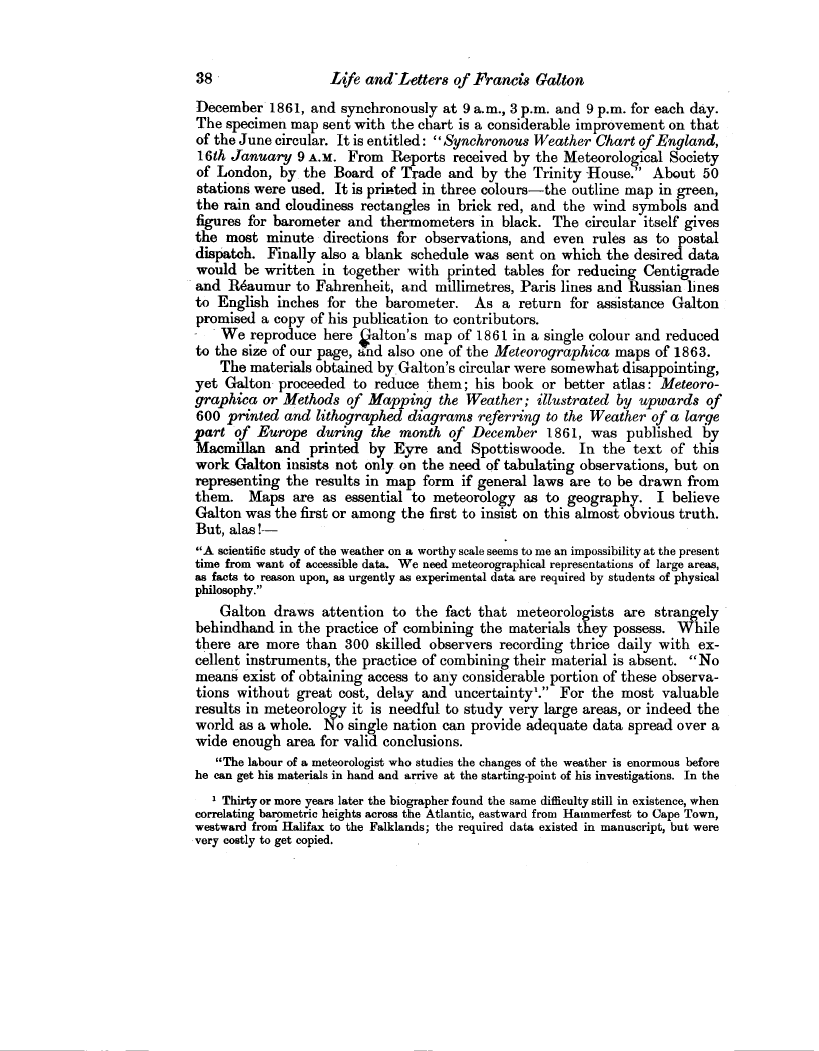38 Life and' Letters of Francis Galton
December 1861, and synchronously at 9 a.m., 3 p.m. and 9 p.m. for each day. The specimen map sent with the chart is a considerable improvement on that of the June circular. It is entitled: "Synchronous Weather Chart of England, 16th January 9 A.M. From Reports received by the Meteorological Society of London, by the Board of Trade and by the Trinity House." About 50 stations were used. It is printed in three colours-the outline map in green, the rain and cloudiness rectangles in brick red, and the wind symbols and figures for barometer and thermometers in black. The circular itself gives the most minute directions for observations, and even rules as to postal dispatch. Finally also a blank schedule was sent on which the desired data would be written in together with printed tables for reducing Centigrade and R6aumur to Fahrenheit, and millimetres, Paris lines and Russian lines to English inches for the barometer. As a return for assistance Galton promised a copy of his publication to contributors.
We reproduce here -alton's map of 1861 in a single colour and reduced to the size of our page, and also one of the Meteorographica maps of 1863.
The materials obtained by.Galton's circular were somewhat disappointing, yet Galton proceeded to reduce them ; his book or better atlas : Meteorographica or Methods of Mapping the Weather; illustrated by upwards of 600 printed and lithographed diagrams referring to the Weather of a large part of Europe during the month of December 1861, was published by Macmillan and printed by Eyre and Spottiswoode. In the text of this work Galton insists not only on the need of tabulating observations, but on representing the results in map form if general laws are to be drawn from them. Maps are as essential to meteorology as to geography. I believe Galton was the first or among the first to insist on this almost obvious truth. But, alas!-
"A scientific study of the weather on a worthy scale seems to me an impossibility at the present time from want of accessible data. We need meteorographical representations of large areas, as facts to reason upon, as urgently as experimental data are required by students of physical philosophy."
Galton draws attention to the fact that meteorologists are strangely behindhand in the practice of combining the materials they possess. While there are more than 300 skilled observers recording thrice daily with excellent instruments, the practice of combining their material is absent. "No means exist of obtaining access to any considerable portion of these observations without great cost, delay and uncertainty'." For the most valuable results in meteorology it is needful to study very large areas, or indeed the world as a whole. No single nation can provide adequate data spread over a wide enough area for valid conclusions.
"The labour of a meteorologist who studies the changes of the weather is enormous before he can get his materials in hand and arrive at the starting-point of his investigations. In the
' Thirty or more years later the biographer found the same difficulty still in existence, when correlating barometric heights across the Atlantic, eastward from Iiammerfest to Cape Town, westward from Halifax to the Falklands; the required data existed in manuscript, but were very costly to get copied.

